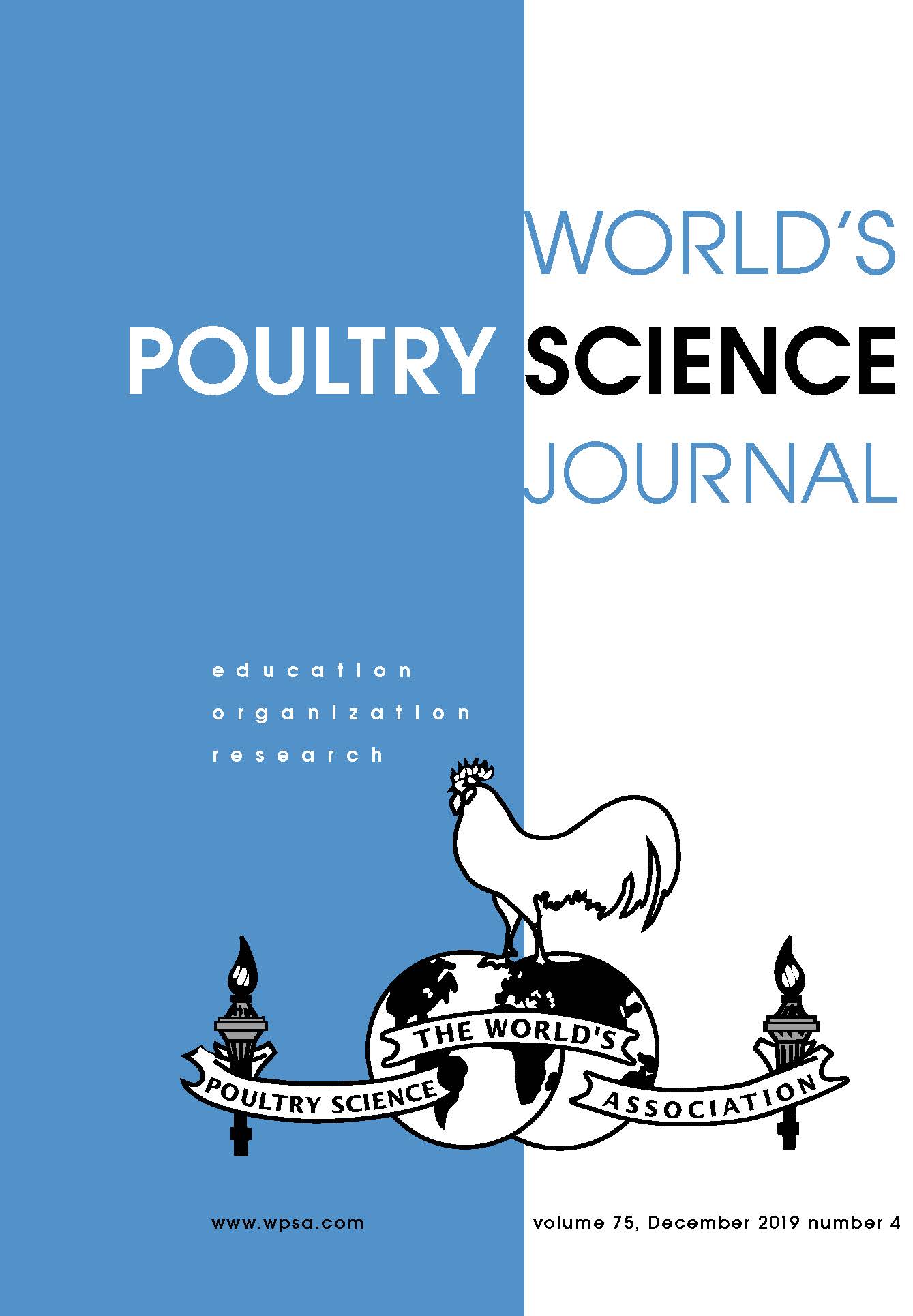Crossref Citations
This article has been cited by the following publications. This list is generated based on data provided by
Crossref.
Englmaierová, M.
Dlouhá, G.
Marounek, M.
and
Skřivan, M.
2012.
Efficacy of contrast levels of non-phytate phosphorus and Aspergillus niger phytase in hens fed wheat-maize-based diets.
Czech Journal of Animal Science,
Vol. 57,
Issue. 11,
p.
499.
Roura, E.
Baldwin, M.W.
and
Klasing, K.C.
2013.
The avian taste system: Potential implications in poultry nutrition.
Animal Feed Science and Technology,
Vol. 180,
Issue. 1-4,
p.
1.
Wilkinson, S.J.
Bradbury, E.J.
Thomson, P.C.
Bedford, M.R.
and
Cowieson, A.J.
2014.
Nutritional geometry of calcium and phosphorus nutrition in broiler chicks. The effect of different dietary calcium and phosphorus concentrations and ratios on nutrient digestibility.
animal,
Vol. 8,
Issue. 7,
p.
1080.
Wilkinson, S.J.
Bradbury, E.J.
Bedford, M.R.
and
Cowieson, A.J.
2014.
Effect of dietary nonphytate phosphorus and calcium concentration on calcium appetite of broiler chicks.
Poultry Science,
Vol. 93,
Issue. 7,
p.
1695.
Morgan, N.K.
Walk, C.L.
Bedford, M.R.
and
Burton, E.J.
2014.
The effect of dietary calcium inclusion on broiler gastrointestinal pH: Quantification and method optimization.
Poultry Science,
Vol. 93,
Issue. 2,
p.
354.
Bradbury, E.J.
Wilkinson, S.J.
Cronin, G.M.
Thomson, P.C.
Bedford, M.R.
and
Cowieson, A.J.
2014.
Nutritional geometry of calcium and phosphorus nutrition in broiler chicks. Growth performance, skeletal health and intake arrays.
animal,
Vol. 8,
Issue. 7,
p.
1071.
Englmaierová, M.
Skřivanová, V.
and
Skřivan, M.
2014.
The effect of non-phytate phosphorus and phytase levels on performance, egg and tibia quality, and pH of the digestive tract in hens fed higher-calcium-content diet.
Czech Journal of Animal Science,
Vol. 59,
Issue. 3,
p.
107.
Morgan, N.K.
Walk, C.L.
Bedford, M.R.
and
Burton, E.J.
2015.
Contribution of intestinal- and cereal-derived phytase activity on phytate degradation in young broilers.
Poultry Science,
Vol. 94,
Issue. 7,
p.
1577.
Beeson, L. A
Walk, C.L.
Bedford, M.R.
and
Olukosi, O.A.
2017.
Hydrolysis of phytate to its lower esters can influence the growth performance and nutrient utilization of broilers with regular or super doses of phytase.
Poultry Science,
Vol. 96,
Issue. 7,
p.
2243.
Ustundag, Ahmet Onder
and
Ozdogan, Mursel
2018.
Effects of Feed Additives Used As an Alternative to Antibiotics on Mineral Absorption and Bone Characteristics in Poultry: A Review.
Hayvansal Üretim,
Vol. 59,
Issue. 1,
p.
79.
Nys, Yves
and
Le Roy, Nathalie
2018.
Vitamin D.
p.
361.
Niknafs, Shahram
and
Roura, Eugeni
2018.
Nutrient sensing, taste and feed intake in avian species.
Nutrition Research Reviews,
Vol. 31,
Issue. 2,
p.
256.
Bradbury, E. J.
Wilkinson, S. J.
Cronin, G. M.
Walk, C. L.
and
Cowieson, A. J.
2018.
Effects of phytase, calcium source, calcium concentration and particle size on broiler performance, nutrient digestibility and skeletal integrity.
Animal Production Science,
Vol. 58,
Issue. 2,
p.
271.
Díaz-Alonso, J.A.
Gómez-Rosales, S.
Angeles, M.deL.
Ávila-González, E.
and
López-Coello, C.
2019.
Effects of the Level and Relationship of Calcium and Available Phosphorus on the Growth and Tibia Mineralization of Broiler Starter Chickens.
Journal of Applied Poultry Research,
Vol. 28,
Issue. 2,
p.
339.
Tizziani, Tarciso
Donzele, Rita Flavia Miranda de Oliveira
Donzele, Juarez Lopes
Silva, Amanda Dione
Muniz, Jorge Cunha Lima
Jacob, Rodrigo de Freitas
Brumano, Gladstone
and
Albino, Luiz Fernando Teixeira
2019.
Reduction of calcium levels in rations supplemented with vitamin D3 or 25-OH-D3 for broilers.
Revista Brasileira de Zootecnia,
Vol. 48,
Issue. ,
Chang, Lingling
Zhang, Rui
Fu, Shengyong
Mu, Chunyu
Tang, Qingping
and
Bu, Zhu
2019.
Effects of Different Dietary Calcium Levels on the Performance, Egg Quality, and Albumen Transparency of Laying Pigeons.
Animals,
Vol. 9,
Issue. 3,
p.
110.
Matuszewski, Arkadiusz
Łukasiewicz, Monika
and
Niemiec, Jan
2020.
Calcium and phosphorus and their nanoparticle forms in poultry nutrition.
World's Poultry Science Journal,
Vol. 76,
Issue. 2,
p.
328.
Zanu, H.K.
Kheravii, S.K.
Morgan, N.K.
Bedford, M.R.
and
Swick, R.A.
2020.
Interactive effect of dietary calcium and phytase on broilers challenged with subclinical necrotic enteritis: 3. Serum calcium and phosphorus, and bone mineralization.
Poultry Science,
Vol. 99,
Issue. 7,
p.
3617.
Salisbury, F.
Cowieson, A.J.
and
Gous, R.M.
2021.
Constraints on the modelling of calcium and phosphorus growth of broilers: a systematic review.
World's Poultry Science Journal,
Vol. 77,
Issue. 4,
p.
775.
Ruhnke, Isabelle
Akter, Yeasmin
Sibanda, Terence Zimazile
Cowieson, Aaron J.
Wilkinson, Stuart
Maldonado, Stephanie
Singh, Mini
Hughes, Patrick
Caporale, Dylana
Bucker, Stephan
and
O’Shea, Cormac John
2021.
The Response of Layer Hen Productivity and Egg Quality to an Additional Limestone Source When Offered Diets Differing in Calcium Concentrations and the Inclusion of Phytase.
Animals,
Vol. 11,
Issue. 10,
p.
2991.

